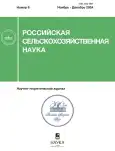study of collection samples of oil flax in the conditions of the southern forest-steppe of the middle volga region
- 作者: Kazarina A.V.1, Shishina A.S.1
-
隶属关系:
- Samara Federal Research Center, Konstantinov Volga Research Institute of Breeding and Seed Production, Russian Academy of Sciences
- 期: 编号 6 (2024)
- 页面: 25-30
- 栏目: Crop production, plant protection and biotechnology
- URL: https://bakhtiniada.ru/2500-2627/article/view/282960
- DOI: https://doi.org/10.31857/S2500262724060046
- EDN: https://elibrary.ru/RVAIPF
- ID: 282960
如何引用文章
详细
The studies were conducted to examine collection samples of oil flax for the main economically valuable traits and to identify the most promising genotypes for involvement in the breeding process. The study was conducted in 2021-2023 in the conditions of the south of the forest-steppe zone of the Middle Volga region. The objects of research are 67 collection samples of oil flax of various ecological and geographical origins. The Kinelsky 2000 variety is taken as the standard. The soil of the experimental plot is typical medium-humus medium-deep medium-clayey chernozem. As a result of the study, the collection samples were differentiated into groups based on the main economically valuable traits that determine the technological effectiveness and productivity of flax (duration of the growing season, total plant height, weight of 1000 seeds, seed yield, elements of the crop structure) in accordance with the broad unified classifier of the CMEA species Linum usitatissium L. (flax). Over the years of study, promising accessions were selected for inclusion in breeding programs as genetic sources of valuable traits: 6 accessions ripening 5-8 days earlier than the standard were selected based on early maturity; 8 accessions exceeding the standard variety by 3.6-13.5 % based on plant height; 11 accessions exceeding the standard by 43.8-87.0 % based on the number of productive capsules per plant; 7 accessions exceeding the standard by 16.9-23.1 based on the number of seeds per capsule; 6 accessions exceeding the standard by 4.4-16.9 % based on the weight of 1000 seeds. Sixteen collection samples were selected (VNIIMK 620, k-4921 (Tajikistan), k-4989 (Ukraine), k-6497 (Kazakhstan), k-6511 (Kazakhstan), Kin x L/2009k, Kin x W/2009k, L-405/2020, Cian (Russia), 27 A-9 (Russia), Betking (Germany), Hindukusz (Afghanistan), Kaufmann (Germany), N.P. 84 (India), Ottawa 5648-M (Canada), Р. 6909 (Czech Republic)) possessing a set of economically valuable traits, the yield of which over the years of research was in the range of 207.8…244.7 g/m², which is 12.1…32.1 % higher than the standard.
作者简介
A. Kazarina
Samara Federal Research Center, Konstantinov Volga Research Institute of Breeding and Seed Production, Russian Academy of Sciences
编辑信件的主要联系方式.
Email: kazarinaav@bk.ru
кандидат сельскохозяйственных наук
俄罗斯联邦, 446442, Samarskaya obl., pgt. Ust’-Kinel’skii, ul. Shosseinaya, 76A. Shishina
Samara Federal Research Center, Konstantinov Volga Research Institute of Breeding and Seed Production, Russian Academy of Sciences
Email: kazarinaav@bk.ru
俄罗斯联邦, 446442, Samarskaya obl., pgt. Ust’-Kinel’skii, ul. Shosseinaya, 76
参考
- Ceh B., Straus S., Hladnik A., Kusar A. Impact of Linseed Variety, Location and Production Year on Seed Yield, Oil Content and Its Composition // Agronomy. 2020. Vol. 10. No. 11. Article 1770. URL: https://www.mdpi.com/2073-4395/10/11/1770 (дата обращения 10.09.2024). doi: 10.3390/agronomy10111770.
- Kiryluk A., Kostecka J. Pro-Environmental and Health-Promoting Grounds for Restitution of Flax (Linum usitatissimum L.) Cultivation // Journal of Ecological Engineering. 2020. Vol. 21. No. 7. P. 99-107. doi: 10.12911/22998993/125443.
- Маслинская М. Е. Оценка уровня продуктивности и адаптивного потенциала сортов льна масличного в условиях Беларуси // Аграрный вестник Урала. 2021. № 9 (212). С. 25-33. doi: 10.32417/1997-4868-2021-212-09-25-33.
- Лукомец В. М., Зеленцов С. В. Методы селекции сои и льна // Вестник российской сельскохозяйственной науки. 2019. № 2. С. 19–23. doi: 10.30850/vrsn/2019/2/19-23.9.
- Федеральная служба государственной статистики. URL: https://rosstat.gov.ru/compendium/document/13277 (дата обращения: 11.09.2024).
- Поморова Ю. Ю., Овсепян С. К., Серова Ю. М. Химико-биологические свойства и потенциальная ценность семян масличного льна (обзор) // Масличные культуры. 2023. № . 1 (193). С. 73-84. doi: 10.25230/ 2412-608X-2023-1-193-73-84.
- Колотов А. П. Реакция льна масличного на условия внешней среды Среднего Урала // Достижения науки и техники АПК. 2021. Т. 35. № 6. С. 20–24.
- Куземкин И. А., Рожмина Т. А. Скрининг образцов коллекции масличного льна по урожайности и их адаптивность в условиях северо-запада России // Достижения науки и техники АПК. 2022. Т. 36. № 8. С. 30–36.
- Сухопалова Т. П. Агротехнологические элементы возделывания льна масличного сорта Уральский // Земледелие. 2021. № 6. С. 33–36.
- Товстановская Т. Г., Ягло М. Н. Ценность генофонда льна масличного по хозяйственным признакам и создание на его основе сортов в условиях южной Степи Украины // Вестник Белорусской государственной сельскохозяйственной академии. 2019. № 1. С. 55–59.
- Сулейманова А. Роль исходного материала в создании новых сортов льна масличного // Международный сельскохозяйственный журнал. 2019. № 3. С. 146–154. doi: 10.24411/2588-0209-2019-10069.
- Косых Л. А., Казарина А. В. Влияние метеорологических условий на хозяйственно ценные признаки льна масличного в лесостепной зоне Среднего Поволжья // Вестник Ульяновской государственной сельскохозяйственной академии. 2020. № 2 (50). С. 98–104.
- Изучение коллекции льна Linum usitatissium L.: методические указания / под ред. Н. К. Лемешева. Л.: ВИР, 1988. 29 с.
- Методика государственного сортоиспытания сельскохозяйственных культур. Общая часть. М., 2019. Вып. 1. 329 с. URL: https://gossortrf.ru/upload/2019/08/metodica_1.pdf (дата обращения: 15.08.2024).
- Международный классификатор СЭВ вида Linum usitatissium L. (лен). Л.: ВИР, 1989. 36 с.
- Доспехов Б. А. Методика полевого опыта (с основами статистической обработки результатов исследований) / 5-е издание доп. и перераб. М.: Агропромиздат, 1985. 351 с.
补充文件









